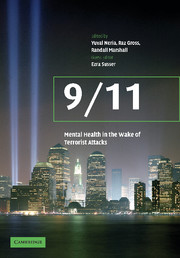Book contents
- Frontmatter
- Contents
- Acknowledgments
- Editors brief bio
- List of contributors
- Foreword
- Part I Introduction
- Part II The psychological aftermath of 9/11
- Part III Reducing the burden: community response and community recovery
- Part IV Outreach and intervention in the wake of terrorist attacks
- Part IV A New York area
- 16 PTSD in urban primary care patients following 9/11
- 17 Project Liberty: responding to mental health needs after the World Trade Center terrorist attacks
- 18 Mental health services support in response to September 11: the central role of the Mental Health Association of New York City
- 19 The New York Consortium for Effective Trauma Treatment
- 20 Evaluation and treatment of firefighters and utility workers following the World Trade Center attacks
- 21 The World Trade Center Worker/Volunteer Mental Health Screening Program
- 22 Child and adolescent trauma treatments and services after September 11: implementing evidence-based practices into complex child services systems
- 23 Relationally and developmentally focused interventions with young children and their caregivers in the wake of terrorism and other violent experiences
- Part IV B Washington, DC
- Part IV C Prolonged-exposure treatment as a core resource for clinicians in the community: dissemination of trauma knowledge post-disaster
- Part V Disasters and mental health: perspectives on response and preparedness
- Index
16 - PTSD in urban primary care patients following 9/11
from Part IV A - New York area
Published online by Cambridge University Press: 27 October 2009
- Frontmatter
- Contents
- Acknowledgments
- Editors brief bio
- List of contributors
- Foreword
- Part I Introduction
- Part II The psychological aftermath of 9/11
- Part III Reducing the burden: community response and community recovery
- Part IV Outreach and intervention in the wake of terrorist attacks
- Part IV A New York area
- 16 PTSD in urban primary care patients following 9/11
- 17 Project Liberty: responding to mental health needs after the World Trade Center terrorist attacks
- 18 Mental health services support in response to September 11: the central role of the Mental Health Association of New York City
- 19 The New York Consortium for Effective Trauma Treatment
- 20 Evaluation and treatment of firefighters and utility workers following the World Trade Center attacks
- 21 The World Trade Center Worker/Volunteer Mental Health Screening Program
- 22 Child and adolescent trauma treatments and services after September 11: implementing evidence-based practices into complex child services systems
- 23 Relationally and developmentally focused interventions with young children and their caregivers in the wake of terrorism and other violent experiences
- Part IV B Washington, DC
- Part IV C Prolonged-exposure treatment as a core resource for clinicians in the community: dissemination of trauma knowledge post-disaster
- Part V Disasters and mental health: perspectives on response and preparedness
- Index
Summary
Introduction
Mass violence disasters, especially terrorist events in urban areas, are hypothesized to have greater impact on mental health than either natural or technological disasters due to their intentional nature (Norris et al., 2002). The density of the urban environment, its ethnic diversity, and expected support deterioration, might exacerbate the disaster effects (Norris, 2002). Studies focused on the exposure to terrorist events in recent years: the 2001 World Trade Center (WTC) disaster (Schuster et al., 2001; Galea et al., 2002; Schlenger et al., 2002; Silver et al., 2002; Vlahov et al., 2002), and the 2000–2002 terrorist attacks in Israel (Bleich et al., 2003), have documented significant psychological problems, in the short term, in both directly and indirectly exposed individuals.
A recent review concluded that the health effects of disasters are wide and adversely affect several aspects of health including generalized distress, psychiatric disorders, physical illness, and interpersonal problems (Norris et al., 2002). Mass violence was found to have greater psychosocial impact than natural or technological disasters, due to its intentional character (Norris et al., 2002). For example, 6 months following the Oklahoma bombing (North et al., 1999) adults injured in that event had markedly elevated rates of post-disaster mental health disorders (45%), including post-traumatic stress disorder (PTSD, 34%).
Political terrorism, and especially suicide terrorism, has emerged as a highly detrimental international problem. As a well planned and executed violent event, suicide terrorism is deliberately intended to cause massive destruction and gruesome death; induce fear and helplessness; diminish safety and stability; weaken crucial social bonds; and disrupt the economic, political, and social order (Kaniasty & Norris, 2004; Neria et al., 2005).
- Type
- Chapter
- Information
- 9/11: Mental Health in the Wake of Terrorist Attacks , pp. 239 - 263Publisher: Cambridge University PressPrint publication year: 2006



